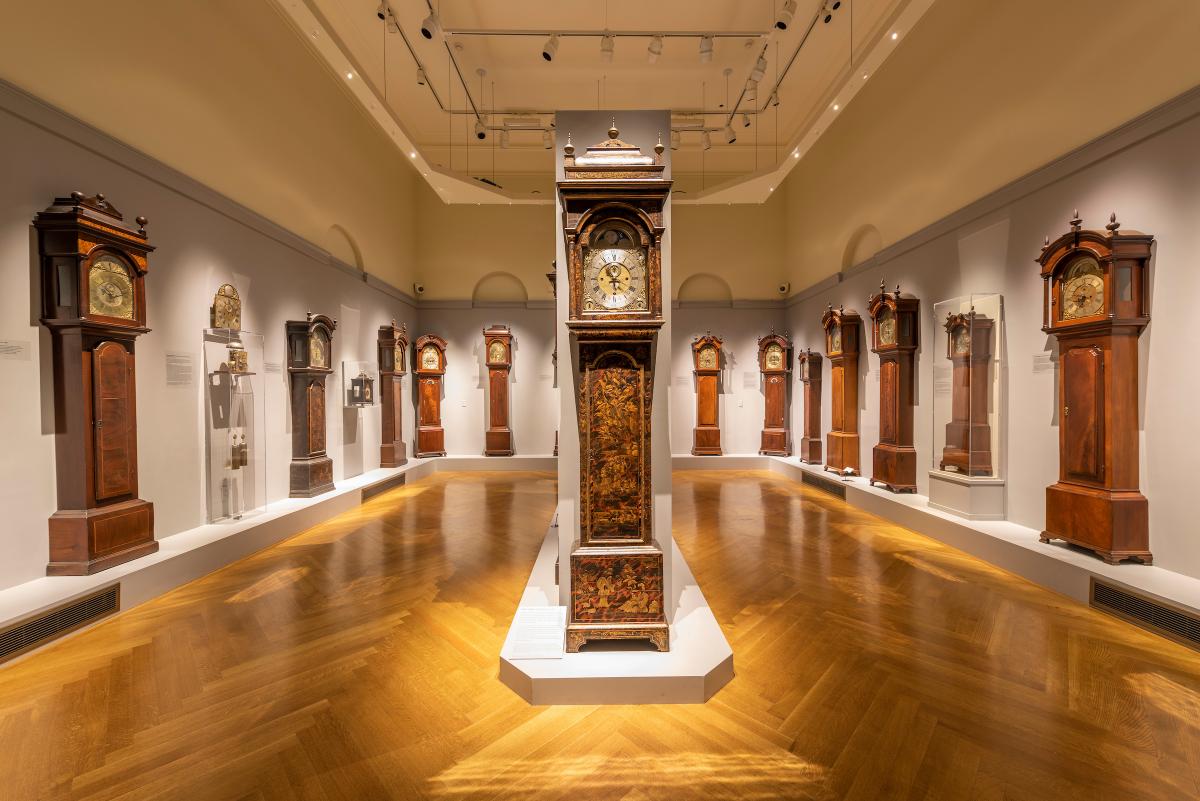
01 Dec The Claggetts: Master Clockmakers in Colonial America December 6, 2018 – April 21, 2019
The Claggetts of Newport: Master Clockmakers in Colonial America featured 35 clocks, the largest assemblage of Claggett and Wady clocks ever brought together—many never exhibited publicly. It examined the range of the Claggetts’ clock production in terms of their technical sophistication, decorative finesse, and context of fabrication.
Drawn from a full roster of public and private collections, the exhibition included pieces from the Metropolitan Museum of Art, Brown University, The Preservation Society of Newport County, Old Sturbridge Village Collection, and the Rhode Island Historical Society. It featured twenty clocks by William Claggett, including his masterpiece: the arch-dial, eight-day quarter-striking clock in japanned case belonging to the Redwood. Thomas Claggett is represented by eleven clocks, while James Wady—to whom only eleven clocks are ascribed—by four clocks, including one using a convex block-and-shell pendulum door, a feature that typified Newport clocks. Among other highlights was a table clock with japanned surface by William Claggett; a trio of Thomas Claggett clocks in related, uniquely regional cases, one a dwarf clock and another a musical clock by him; and two uncased eight-day time and strike movements enabling visitors to peer into the mechanics of a working clock.
The exhibition included many clocks borrowed from private collections that feature significant provenance information. Preserved by Rhode Island families, some for 300 years, the identities of the original owners of several examples are documented and early family histories are known for others, shedding light on the value, details of construction and the circumstances governing commissions.
“This is an unprecedented presentation of clocks that is unlikely ever to be duplicated. With the recent book devoted to the Claggetts by Fennimore and Hohmann, the Claggetts’ achievement as a highpoint of early American craftsmanship can now be comprehensively appreciated,” said exhibition co-curator Gary R. Sullivan, the leading authority on early American clocks.
Organized by the Redwood Library & Athenæum—the sole venue— The Claggetts of Newport: Master Clockmakers in Colonial America juxtaposed significant early square dial clocks with later, highly elaborate clocks featuring japanned cases and complex movements indicating the day, tides, and phases of the moon. The clocks’ increasing technical and decorative elaboration over the course of the eighteenth century coincided with the growing prosperity of Newport’s merchant class, whose patronage fueled the city’s emergence as a major colonial artistic center.
The exhibition charted a complex narrative that teases out the three distinct personalities that comprise the Claggett dynasty—William Claggett (1694-1748), his assumed relative Thomas Claggett (d. 1797), and William’s son-in-law James Wady (ca. 1706-1759). As well, the show offered insights on the network of sub-contracted specialist case makers, brass founders and glaziers that the Claggett workshop relied on to produce their clocks.
The technical expertise required to produce a clock, whereby founders cast brass parts that clockmakers filed into the finished movement and positioned inside custom casework made these more than “a great ornament to [a] Room.” The Claggett’s ascendency as clockmakers coincides with the entry of science into public discourse through newly-formed philosophical societies, such as Newport’s Literary and Philosophical Society (1730), the group integral to the founding of the Redwood Library, whose members met to discuss current political and scientific issues. William Claggett himself experimented with electricity, and evidence abounds that clocks were conceived as far more than time pieces: in a 1725 pamphlet Benjamin Franklin compares God’s regulation of the world to the movement of a clock, a metaphor used and critiqued later by the philosopher George Berkeley.
The Claggetts of Newport: Master Clockmakers in Colonial America was co-curated by Gary R. Sullivan and Benedict Leca. The Redwood gratefully acknowledges support from the Edward W. Kane and Martha J. Wallace Family Foundation, and by several donors who wish to remain anonymous. Further support for the gallery presentation came from Cornelius C. Bond and Ann E. Blackwell, and an in-kind donation by Sandra Liotus Lighting LLC.
Co-curators: Gary R. Sullivan and Benedict Leca
“This is an unprecedented presentation of clocks that is unlikely ever to be duplicated. With the recent book devoted to the Claggetts by Fennimore and Hohmann, the Claggetts’ achievement as a highpoint of early American craftsmanship can now be comprehensively appreciated,” said exhibition co-curator Gary R. Sullivan, the leading authority on early American clocks.

Sorry, the comment form is closed at this time.